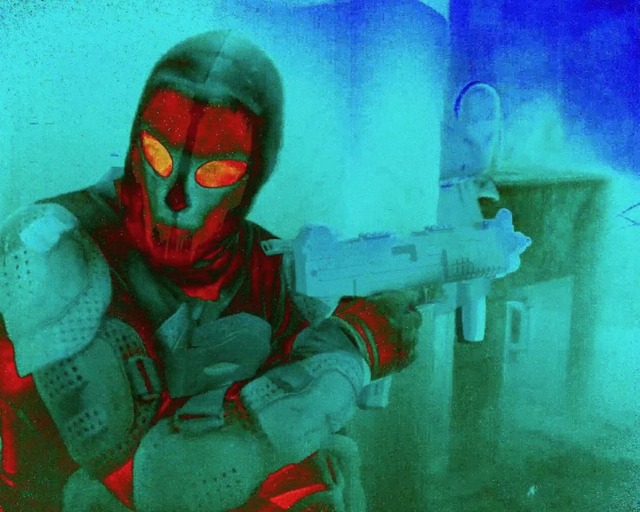 AGGRO DR1FT still.
AGGRO DR1FT still.
If you were one of the few people who caught an IMAX screening of Christopher Nolan’s Tenet when theaters were still largely locked down, you might have seen the music video for Travis Scott’s song “Franchise” ahead of the film. The fawning IMAX press release makes the short video clip sound like a banquet for the senses, boasting of “powerful precision sound and the highest quality crystal clear imagery on the biggest screens.” The collaboration speaks to how Scott has positioned himself as an artist: more than the music, the Travis Scott brand is about visual spectacle. Almost every move he makes is an attempt to one-up not just his own image, but that of the entire rap game, by constantly accelerating the blockbuster scale of his work and generating an almost religious feeling of awe in his fans as they lose themselves in a furnace of pure rage. More bodies in the crowd, more speakers, more money spent, more everything.
It’s not enough for Travis Scott to simply make a movie, it has to be filmed in IMAX with surround sound. Travis Scott can’t just launch a tour in any old stadium either. It has to be a full-blown experience, at an iconic landmark like the Pyramids of Giza or the Circus Maximus in Rome . Travis Scott is not the first musician whose concerts have ended in real-life harm and injury, but he is probably the only musician accused of opening up a literal portal to hell in the process — the conspiracy theories around the Astroworld Festival have only helped to turn the tragedy into an even greater spectacle.
If it wasn’t already evident that Travis Scott sees himself more like an auteur than a mere mortal rapper, his recent work as a curator of cinematic vibes makes it clearer than ever. Alongside the release of this year’s Utopia, Scott dropped the omnibus film Circus Maximus, a navel-gazing IMAX extravaganza that owes as much to Kanye’s Runaway film and the Yeezus tour as the album’s production does to “I Am a God.” The film features colorful segments from dorm room poster auteurs like Nicolas Winding Refn and Gaspar Noe which function as standalone videos, and culminates in a performance at the Amphitheatre of Pompeii filmed by professional rapscallion Harmony Korine.
The two seem to have hit it off, because Scott’s latest dramatic turn is in another Harmony Korine project, AGGRO DR1FT, an experimental thriller that serves as the calling card for the Florida-based transgressor's new media start-up EDGLRD. Befitting of a 50-year-old man who would found a company called “Edgelord,” AGGRO DR1FT is 80 minutes of debased sensory pleasures, a series of moving images meant to be experienced more than attentively watched, in the same way that Travis Scott albums function better as party soundtracks than active listening.
Though AGGRO DR1FT screened at prestigious film festivals from Venice to New York, it’s strange to observe in that environment because it’s something so clearly meant to be absorbed in the muted haze of a drug experience. In Hype Williams’ Belly, there’s an infamous scene where Nas is hanging out with DMX at his mansion; Harmony Korine’s debut feature Gummo plays on a screen in the background — if Belly was remade in 2023, it would probably be Playboi Carti and Ken Carson xanned out while AGGRO DR1FT washes over them. Those hoping for a straight-up Travis Scott action vehicle will probably be disappointed by AGGRO DR1FT on several levels, mostly because it’s not really a Travis Scott movie. Spanish actor Jordi Mollà stars as an aging hitman, adrift somewhere in the day-glo nightmare of Florida, who simply wants nothing more than to be done with his work so he can return home to his hot wife with a massive bubble butt. It’s the simple things in life, after all.
That basic narrative framework — the old criminal back in for one last job — is pure genre boilerplate, but Korine uses it as an excuse to push at the very limits of what we consider a “movie.” Korine has long been more interested in the visual texture of film itself than conventional narratives — the snuff-like videotape of Trash Humpers, or the blown-out film grain of Julien Donkey-Boy — but AGGRO DR1FT positions itself as an almost anti-cinematic experience. The entire film is shot with infrared thermal energy, rendering reality as a kaleidoscope of reds and yellows, reducing bodies to the outline of their existence. Any human flesh shown on screen is constantly mutating thanks to AI post-production work which transforms skin tones into vivid wallpaper-like patterns. It’s all set to a throbbing trance score from AraabMuzik, in his debut as a film composer, which propels you through the blotted and hypnagogic experience.
The pseudo-CGI style of AGGRO DR1FT lands somewhere between the shape-shifting rotoscoping animation of Richard Linklater’s Waking Life, a music video filmed in Second Life, Adult Swim’s Xavier: Renegade Angel, and those old iPod commercials. It’s an aesthetic that Korine has described as “gamecore,” which is fitting, since the humans on-screen frequently behave like NPCs more than actual characters, repeating the same words over and over as if stuck in place. At the end of Korine’s Spring Breakers, the former Disney starlets hype themselves up to murder Gucci Mane by telling themselves that “it’s just a video game” — a video game that Harmony Korine has now in many ways made with AGGRO DR1FT.
Travis Scott appears in only a handful of scenes as the hitman’s dutiful pupil Zion, but Korine could not have picked a more fitting rapper for his muse. Just like AGGRO DR1FT is frequently more about how it looks than what exactly you’re looking at, Travis Scott’s music is generally more about the sound of his voice than what he actually says with it. The AutoTuned breaths, the massive Mike Dean synthesizers, the overwhelming drums: it’s all about losing yourself in a feeling, instead of asking what that feeling is.
There’s something distinctly cinematic about Scott’s sound; the constant beat switches on songs like “Sicko Mode” and “Meltdown” mimic the three-act structure of a scripted narrative. His album titles — Rodeo, Astroworld, Utopia — posit the experience of his music as a physical environment, a theme park you pay to enter, hence his constant invocation of music festivals from Bonnaroo to Burning Man. Like the overlord of some twisted Candyland, Scott offers up a constant stream of desserts, with little substance. No wonder he constantly talks about sweet treats, from apple pies to candy canes to Jamba Juice smoothies—when Travis takes Ketamine on recent single “K-POP,” of course it’s in lollipop form.
The heavy modulation of Travis Scott, whether his voice on record or his image in AGGRO DR1FT, has an ultimately alienating effect. Throughout his career, Scott has imagined himself not as an Afrofuturist visitor from another world, but as literally inhuman: as a poseable action figure in the Hype Williams-directed video for “90210,” or as a wearable skin in Fortnite. In his Circus Maximus performance, he’s the frontman to a literal animatronic robot band, his eyes unseen behind Geordi LaForge glasses, flanked by a dystopic wall of sound.
More than a rapper, Travis Scott is an avatar, a blank slate for listeners to project upon as if they’re dropping into the body of a protagonist in a video game. By stripping any pretense of personal storytelling or human emotion from his music, Scott has become almost like a living logo, and thus more conducive to “synergized” business partnerships. Even if Travis Scott’s role in AGGRO DR1FT is smaller than anticipated, his mere presence makes it part of the Travis Scott brand, weaving an outsider video art piece into the same extended universe as his business collaborations with McDonald’s and Reese’s.
Harmony Korine is an artist who equally blurs the lines between branded entity and human being, whose image has been shaped as much by trolling Letterman appearances and public performances as his movies themselves. He moves equally between the cinematic avant-garde, the Miami Basel industrial complex of contemporary art, and the corporate boardroom — in addition to his music video work for stars like Rihanna, Korine is a regular freelancer for high-end brands like Dior and Gucci. As much as a film like AGGRO DR1FT seeks to exist on the cutting edge, it’s also a clear product, a business partnership between two artists who see how their bread is buttered: it’s all about the branding.
Rap Column is a column about rap music by Vivian Medithi and Nadine Smith for The FADER.
